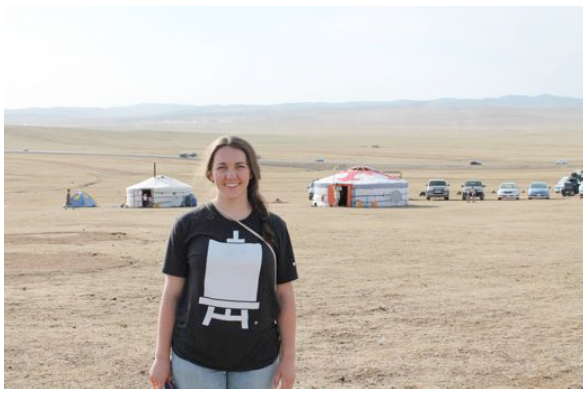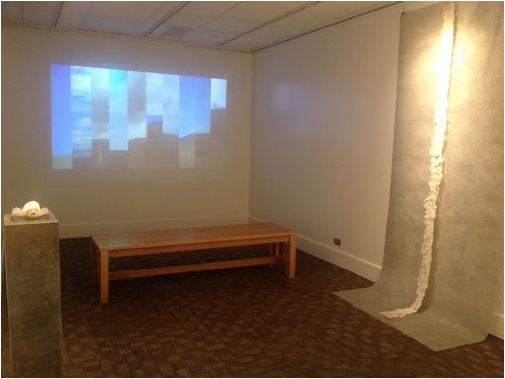Sarah Waldron and Daniel T. Barney, Art Education
After spending time in Switzerland with Mongolian immigrants back in 2012, I became interested in their culture and heritage. I attended several events with my Mongolian friends in Switzerland, most notably a cultural event in the summer time called Naadam, or what we describe in English as the festival of three manly sports. Although their customs and traditions differ from mine, I noticed that we share many common values. I recognized in these people a familiar sensitivity to areas such as: family, pilgrimage, community, language, spirituality, and service. All of these areas correspond with my ideas, and also those promoted by BYU.
When I approached Dr. Daniel T. Barney for help in developing a way to create a meaningful project that would allow me to explore Mongolian culture, and to do it in a relevant and beneficial way for others at the University, we determined that the best way for me to align the experience with my education efforts would be to travel to Mongolia, attend the Naadam national festival in the capitol city, learn traditional craft techniques such as felting, and participate in other cultural outlets. We discussed a plan to create original artwork to be displayed publically on campus after returning from Mongolia. In this report, I will detail some of the important aspects of this project and some of what I learned and shared from the project as a result of my experience.
I traveled to Mongolia in June 2015. The duration of my travels was about three weeks. While in Mongolia, I attended several events during the Naadam festival. I observed the opening ceremonies, and saw Mongolian wrestling and horseback riding events. It was meaningful to me to see how the Mongolian people put on these large sporting events and other traditions during this time of year such as family gatherings, the wearing special holiday vestments, and preparing traditional foods. I visited Buddhist monasteries and learned about religious traditions in museums and from talking with others. I attended LDS services and learned much from interacting with the Mongolian Latter-Day Saints. A favorite church-related activity was going into the countryside and experiencing a Mongolian khorkhog, or Mongolian barbeque. It is more like mutton stew than what the popular western restaurants serve as Mongolian barbeque. I sampled various Mongolian foods each day, and observed how Mongolians rely on their resources to live. Animals such as yak, cows, camels, sheep, horses, and goats contribute much toward the livelihood of Mongolians. Fermented mere’s milk is an essential part of their holiday traditions, both for consuming and in ritual activities. Meat and dairy products make up much of the traditional diet.
Felting is an important trade in Mongolia. Also, other fiber-based industries such as cashmere apparel and Mongolian rugs are significant business activities. I learned to make felt from an accomplished felt maker, and visited several factories that process yak, camel, and goat hair, as well as leather shoe-making facilities. I attended cultural performances such as Mongolian opera, throat singing, dance, and other performances. I also experienced traditional contemporary Mongolian music and television. I was privileged to see many important landmarks including Soviet memorials and other statuaries, and the largest horse statue in the world with a large figure of Genghis Khan sitting atop. I was interested to learn much about him. In addition to staying in the city, I was able to stay in a traditional Mongolian shelter in the countryside called a ger. It was located in the Mongolian national park, Terelj. While there, I was able to see many yaks, observe native plants such as Edelweiss, and eat other traditional food that I had not tried before. I visited many local shops, both small and commercial. I also enjoyed going to many different kinds of markets. I learned about different regions of Mongolia by attending historical museums.
I was fortunate to have someone to translate for me everywhere I went. I wished that I could have learned more of the language and would still like to do so. The friends I met in Switzerland helped me achieve many of my learning goals, as well as a contact provided to me by Dr. Barney who is a friend and colleague of his from Provo and had been living in Ulaanbaatar with his wife for several months. His knowledge and perspective on Mongolian culture were invaluable in my many experiences while I was in Mongolia. On the way home, I traveled through China. I benefited from the time spent there by asking my Chinese tour guide for a Chinese perspective on their history with Mongolia.
Throughout the trip, I documented my experiences and things I learned. I captured those memories through photography, journal writing, recording videos, and collecting ephemera. When I returned home, I had a lot of resources to draw from to create artwork for the exhibition. The art was displayed in the Harold B. Lee library. In the show I displayed one video piece, one composite photograph, and five objects. With the help of my mentor, the title chosen for the show was Mongolia: Partially Seen. Each element in the installation reflected Mongolian culture. It was not meant to be a literal representation. Dr. Barney had advised me to avoid using cultural appropriation, but instead allow the culture I experienced to inform my work in a way that was relevant to my experience and those who would see the work. Something from the trip I realized was the significant yet fragmented and fleeting nature that travel affords. I hoped to recreate certain feelings and impressions that I experienced in Mongolia so patrons could make meaningful connections with the work. I created some wool-based works formed by the felting techniques I learned in Mongolia. Getting the wool from a place that is culturally significant to my family helped support the ideas of family, sharing, and livelihood that I observed among the Mongolian people. I hosted a reception at the show and provided many Mongolian artifacts. Patrons who came that night were able to come to a separate room from the art show. Those who wanted to could handle artifacts and ask questions about Mongolia. This space acted as a learning environment and an extension of the physical artwork. Prior to my trip to Mongolia, I took a course on socially engaged artwork from Dr. Barney. Part of the reception was inspired by some of the ideas from that course.
I believe it is important to become informed in cultures and ways of living that differ from what we were born into. Doing so can result in enriching and powerful experiences. Travel can be self-centered and fleeting, but by asking the right questions and engaging with other cultures in a productive way, we can glean from others and contribute to our own communities. Visual arts afford us the means to translate experience and knowledge into a visual way of communication. Before taking a serious interest in Mongolia, I knew little to nothing about this rich culture. By taking a determined look beyond my sphere of influence, and immersing myself even for a short time Mongolia, and subsequently creating artwork related to this experience, I had an opportunity to share with others some information about a fascinating culture that seems to be underrepresented in our community.
On the Mongolian Steppes during Naadam, with Mongolian ger’s
Image from art exhibit showing video piece and two felt objects


